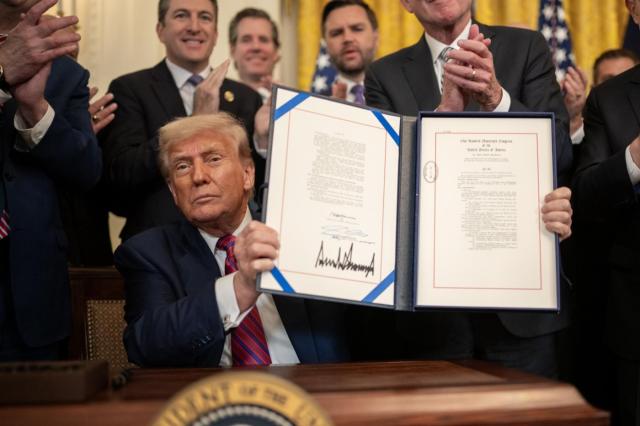Author: Meng Yan's Blockchain Thoughts
After the U.S. Congress passed the GENIUS Act, President Trump signed it into law on the afternoon of July 18, 2025 local time.
The United States passes many laws every year, but this stablecoin legislation will definitely be considered one of the most important milestones in modern monetary history, comparable to the Bretton Woods Conference and the Nixon Shock.
So far, discussions in the Chinese community about U.S. dollar stablecoins have mainly focused on the innovative opportunities and wealth dividends they bring, with far too little attention paid to the challenges they pose, and even fewer people willing to explicitly point out that China has fallen seriously behind and is in a very passive situation in this field.
In fact, it's not just China - every non-dollar economy is now facing a serious challenge.
Due to the penetrative nature of blockchain technology, the near-100% dominance of U.S. dollar stablecoins, and the sudden change in U.S. stablecoin legislation with a preemptive approach, for almost all countries outside the U.S., a battle to defend monetary sovereignty is unavoidable. Some countries in Latin America and Africa, whether proactively or passively, have left their doors wide open, with U.S. dollar stablecoins penetrating deeply into people's daily economic activities. In Brazil and Argentina, USDT payments have become extremely common. In Nigeria, reports suggest that up to one-third of economic activities are paid in USDT. At present, these countries are unable to regulate this part of economic activity, let alone tax it. This means that this part of their economic activity has essentially been removed from national control at the management and fiscal levels and incorporated into the broader U.S. dollar economy.
Most countries cannot sit idly by and watch this digital economic colonization spread, but what can they do? Close the door and develop their own system, or simply prohibit stablecoins? Many countries have done this in the past few years, and practice has proven that not only is this approach ineffective, but it also has a more serious potential problem: falling behind in long-term competition in financial, internet, AI, and other technological fields. In a sense, the challenges many countries face today are the direct consequence of their previous passive attitudes.
Simple copy-and-paste will also be difficult to achieve. Recently, many financial institutions and enterprises in multiple countries have announced ambitious stablecoin issuance plans. But frankly, the idea that obtaining a stablecoin issuance license, holding a grand launch conference, and then being able to ride the stablecoin economic rocket to success, or even secure a place for their national currency in the chain economy, is naive. Issuing a stablecoin is simple, but the real challenge is how to distribute it, break out of your own ecosystem, and convince millions or even hundreds of millions of users to abandon their U.S. dollar stablecoins and use yours? How can you attract thousands of innovators to develop wallets, custody, payment, exchange, lending, and other applications around your stablecoin? How can you get mainstream internet applications like e-commerce, gaming, live streaming, and social media to adopt your stablecoin? If competing with the U.S. dollar in traditional finance is already extremely difficult, then competing in the stablecoin field would be at least ten times more challenging. To make even a small breakthrough requires an unimaginable cost and long-term effort, along with extremely clear judgment.
What can be done?
Before discussing countermeasures, we should perhaps first ask: How did things come to this point?
Blockchain is not a suddenly emerging new technology, nor did U.S. dollar stablecoins achieve $260 billion and 99% market share overnight. The stablecoin revolution was not a surprise attack, let alone a sneak attack, but a long-announced major offensive. Over the past decade, numerous blockchain experts repeatedly warned that blockchain and digital currency technologies have a dimensionality-reducing advantage over traditional financial systems and are a strategic technology that requires advance planning, early layout, and seizing the initiative. If not actively addressed, one would be in a very passive position in the future. However, regulatory authorities and industries in many countries turned a deaf ear to this, dragging things to this passive situation. In comparison, why is there such high sensitivity and such a strong catch-up awareness when facing the equally disruptive and risky AI technology? Why can mainstream public opinion present such passionate and optimistic attitudes? If they could apply half the enthusiasm towards blockchain and stablecoins as they do to AI, the current situation of U.S. dollar stablecoin hegemony would not exist. If two or three non-U.S. dollar stablecoins could compete with the U.S. dollar, the competition around stablecoins in the coming years would certainly have more variables and excitement.
What a pity! What a sigh!
What exactly went wrong?
Was it a lack of timely attention? No. Since 2014, domestic discussions around blockchain and digital assets have gone through multiple ups and downs. Whether it was academic forward-looking exploration, industry technical experiments, or even periodic research by regulatory agencies, related voices and efforts never stopped. Various think tanks, research institutes, and university laboratories have published in-depth analysis reports, and the financial industry has organized multiple closed-door meetings and tabletop exercises. It can be said that at least at the knowledge level, we were not unprepared, and some viewpoints were even leading internationally in terms of depth and foresight.
Were the principles not explained clearly? Not really. By the time Facebook announced its Libra stablecoin plan in 2019, industry discussions about blockchain and stablecoins were already very deep. If someone were to review the reports from leading research institutions at that time, such as those compiled by the Digital Asset Research Institute, they would find that all the issues we can see today were already identified then. The discussions at that time were even more comprehensive and profound than those of the "stablecoin experts" who became experts in three months through short videos.
Was the communication unprofessional? No. Many financial professionals spoke out early. For example, Dr. Xiao Feng, a finance Ph.D., has been explaining the technical superiority of blockchain since 2016, especially emphasizing the technical characteristics of blockchain distributed ledger payment, clearing, and settlement as a three-in-one, one-step solution. He clearly pointed out that this point alone would bring a hundredfold efficiency and cost advantage, ultimately triggering an upgrade of financial infrastructure - an unstoppable trend. This logic could not be clearer, the argument could not be more professional, and it gained widespread dissemination.
Was it due to crypto chaos leading to misjudgment? For the general public, perhaps, but for true professionals, such an excuse does not hold. As early as 2016, domestic blockchain discussions clearly distinguished speculative digital currencies from blockchain technology. After 2019, with deepening discussions about "industrial blockchain", the industry had long studied the application boundaries and management principles of using blockchain for evidence preservation, rights confirmation, and value transfer. If these studies had been taken seriously, the problem of throwing out the baby with the bathwater would never have occurred.
What is the reason behind this?
A few days ago, I heard a statement that at a high-level closed meeting, a financial official admitted that they had fully understood the disruptive potential of stablecoins and blockchain technology years ago. However, due to the Biden administration's hostile attitude towards blockchain, they judged at the time that the technology had no future. Unexpectedly, after Trump took office, he quickly changed his attitude and promoted stablecoin legislation, catching everyone off guard and leading to a very passive situation. He concluded that we should adopt a more proactive attitude towards technological innovation in the future.
Coincidentally, I have recently been frequently communicating with traditional financial experts about stablecoins and showcasing our developed solutions for smart payment and digital bill stablecoins. A Wall Street financial expert told me after reviewing these that if these applications were to be widely implemented, they would inevitably cause a disruptive impact on traditional banking services, reconnecting customers, funds, and business relationships. However, Wall Street is not unaware of this; many large banks have been using blockchain internally for years and are very clear about its advantages and disruptive potential. But they feel that precisely because blockchain is highly disruptive, regulators will suppress its development based on maintaining stability, "to maintain the stability of the financial industry". During the Biden administration, the authorities indeed maintained this tacit understanding. If it weren't for a table-turning figure like Trump, if the relationship between the Federal Reserve, Wall Street, and the White House hadn't unexpectedly changed, it would be hard to imagine the US government would release this "fierce tiger" of stablecoins at this time.
The situation in other countries is similar. In Australia, we participated in the central bank's CBDC pilot in early 2023 and achieved a winning ranking. The Australian central bank highly praised the technical advantages demonstrated by CBDC and stablecoins in this pilot, but after the evaluation, they decided to keep it under wraps and indefinitely postpone the implementation of CBDC and stablecoins. In private communications with central bank officials, they told me that CBDC and stablecoins faced collective resistance from Australian commercial banks, and the entire pilot project was destined from the beginning to be just an innovation showcase with no breakthrough impact. In Singapore, after maintaining a tolerant and supportive attitude towards the blockchain and digital asset industry for many years, some changes occurred after this year's general election. Analysis suggests that the new government is worried about the potentially disruptive impact of stablecoins and digital assets on the financial industry.
From the above, it's clear that everyone already knew the technical advantages of blockchain and stablecoins, and even acknowledged this as an inevitable trend. However, due to concerns about the risks and potential impact on existing interest structures and institutional frameworks, they deliberately chose to remain numb and sluggish after careful consideration. Or, in simpler terms, everyone is consciously pretending to sleep, hoping to make the dream last a bit longer.
Comparing this with AI makes it even clearer. Seriously speaking, AI's disruptive potential is no less than that of stablecoins and blockchain, with more comprehensive risks, deeper impact, greater potential for destruction, and less predictable consequences. If suppressing blockchain development is to control risks and maintain stability, then the same should apply to AI. However, in the AI competition, Silicon Valley naturally fired the first shot, so no one waited, hesitated, or overthought - everyone was fully armed and rushed into the competition. In the blockchain field, however, people have long formed a bizarre tacit understanding that the first shot to shatter the dream must not be fired by oneself.
Well, now Trump has fired this shot without hesitation, and he is well aware that during the period when everyone was waiting, procrastinating, and pretending to sleep, the US dollar stablecoin has quietly completed a dominant deployment in the global chain space, covering users, scenarios, liquidity, and developer networks. It can be said that the chessboard is set, just waiting for the pieces to be placed. What Trump did was merely to go with the flow and play this already-prepared trump card, using a single bill to push a "super-sovereign US dollar network" onto the historical stage, throwing a naked declaration of war in the face of every non-US dollar economy. Externally, it announces that the global monetary landscape's reorganization has entered a substantive stage; internally, it redefines the collaborative approach between the US national machine and technology, finance, and capital markets. For the world, from now on, this will no longer be a topic that can be delayed, blurred, or "tested while observing" - it will become an urgent matter on the desks of most countries' central banks, finance ministries, and regulators, an inescapable real challenge.
How to respond to this challenge may be a question that will take many years to answer. But before entering the solution, we must first have the courage to face reality, dare to admit: we missed the opportunity, we misjudged the situation, we covered our eyes with our obsession with short-term stability and luck, turning a blind eye to the steel-hard technological logic.
At the starting point of this new global financial order reconstruction, we perhaps should first put down our arrogance and prejudice and say sorry to blockchain. Not for emotional release, but to re-establish a point of understanding. We need to re-recognize the production relations innovation this technology represents, re-embrace the institutional experiments driven by this generation of developers, and re-plan our position in the global digital value network. Perhaps only then will we have a chance to win our place in this digital economic competition that concerns the future global landscape.






